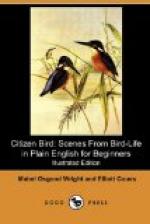Length from eighteen to twenty-three inches, the difference being due to the tail of the male, which in summer has the middle feathers eight or nine inches long.
This Duck differs more in summer and winter plumages than any other. In winter, the only season it is seen in the United States, the male varied with black, white, and silvery-gray, the bill orange and black. In summer he has much more black than white or silver, with some bright-reddish feathers on the wings. The bill is black and orange; the eyes are red.
A Citizen of North America and other parts of the northern hemisphere, never going very far south, and making his summer home in the Arctic regions. He is a noisy, lively, sociable Duck, who has in spring some pleasing notes, so mellow and musical that he may almost be said to sing; but he is not choice or dainty in his food, and the flesh is too rank for House People to eat. He has many absurd names besides “Old Squaw.”
The Hooded Merganser
Length sixteen and a half to eighteen inches.
Male: a beautiful black and white crest rising up high in a rounded form, but very thin from side to side, like a hood ironed flat. Head, neck, and back black; belly and breast white; sides cinnamon-brown with fine black bars; a white mirror with black edges on the wing. Bill black, round like a lead-pencil, with a hook at the end, and strong saw-like teeth along the sides; eyes yellow.
Female: without any such crest as her mate has, and brown where he is black.
A Citizen of North America, very handsome and stylish when he is in full dress; but he is a Fishing Duck, and therefore not very good to eat, though not as rank as other Mergansers. Like the Wood Duck, but unlike nearly all other members of the Duck tribe, this Merganser builds his downy nest in a hollow tree or stump.
CHAPTER XXXI
GULLS AND TERNS AT HOME
[Illustration: Herring Gull.]
Gull Island was only a great sand heap, anchored by rocks and covered with coarse grass; but the children had hardly taken a few steps along the beach when they began to exclaim at the number of strange birds. Some were flying, others walking about on the sand, where there were many tufts of grass and mats of seaweeds that looked as if they had been used for nests. Dodo nearly stepped upon a couple of greenish, dark-spotted eggs, that were nearly as large as a Hen’s. “Are the Gulls still nesting, Uncle Roy? And what are those dark streaky birds over there?”
“These are left-over eggs that did not hatch, for nesting is over in July at latest, and the dark birds are young Gulls in their first plumage. They are brownish gray, streaked and spotted as you see, while the old birds are snow-white with pearl-gray backs, and black and white wing-markings in the summer, though their winter dress is not quite so pure, being streaked with gray on the neck.”




